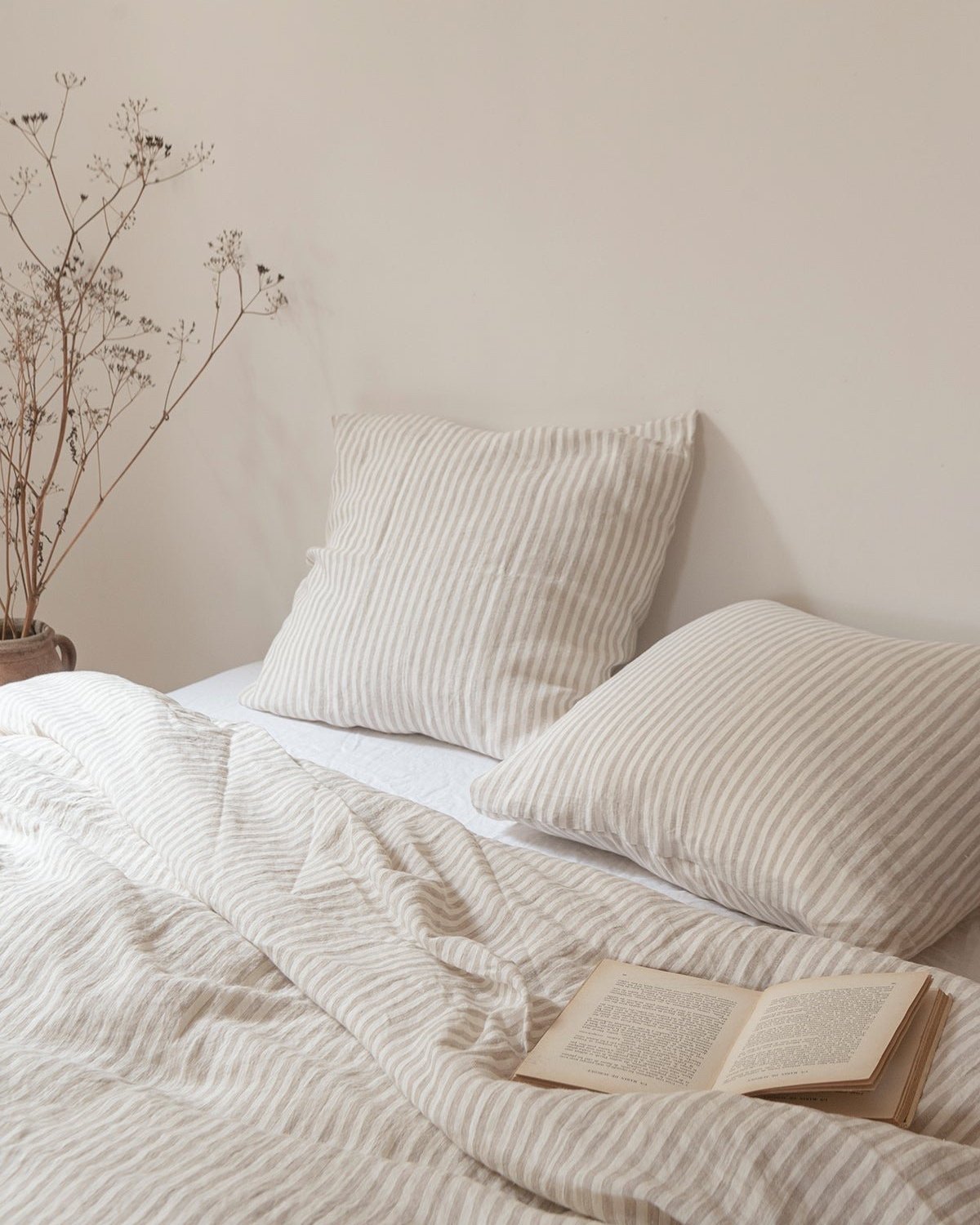Eco-friendly bedding options include sustainable and environmentally friendly alternatives that promote a greener lifestyle. By choosing bedding made from organic materials like bamboo, hemp, or organic cotton, you can reduce your environmental impact.
These natural materials are not only better for the planet but also offer comfort and quality for a restful night’s sleep. Sustainable bedding options are becoming increasingly popular as consumers become more conscious of their ecological footprint. Making small changes like switching to eco-friendly bedding can make a big difference in supporting a healthier planet for future generations.
Contents
The Importance Of Eco-friendly Bedding
Eco-friendly bedding offers sustainable and environmentally conscious alternatives for a greener lifestyle. Choosing eco-friendly bedding options helps reduce waste and lessen environmental impact. Opting for organic materials like bamboo or organic cotton promotes a healthier planet and a better night’s sleep.
Why Green Matters In The Bedroom
Creating an eco-friendly home goes beyond just recycling or using energy-efficient appliances. One area that often gets overlooked is the bedroom, specifically our bedding choices. The bedding we sleep on can have a significant impact on our health and the environment. By opting for sustainable and environmentally friendly bedding alternatives, we can make a positive change and contribute to a greener planet.
Health And Environmental Benefits
Choosing eco-friendly bedding options offers several health and environmental benefits:
- Reduced Exposure to Harmful Chemicals: Traditional bedding often contains synthetic materials and chemicals that can off-gas harmful toxins while we sleep. Eco-friendly bedding, on the other hand, is made from natural and organic materials, reducing our exposure to these chemicals and promoting better indoor air quality.
- Sustainability: Eco-friendly bedding alternatives are typically made from renewable resources, such as organic cotton, bamboo, or hemp. These materials require fewer pesticides, fertilizers, and water to grow, making them more sustainable options compared to conventional bedding materials.
- Biodegradability: When it’s time to replace our bedding, eco-friendly options are biodegradable and break down naturally without causing harm to the environment. Conventional bedding often ends up in landfills, where it contributes to pollution and takes years to decompose.
- Supporting Fair Trade and Ethical Practices: Many eco-friendly bedding brands prioritize fair trade practices, ensuring that workers involved in the production process are paid fair wages and operate in safe working conditions. By choosing these brands, we support ethical practices and contribute to a more equitable world.
By embracing eco-friendly bedding options, we not only prioritize our health and well-being but also play a part in protecting the planet for future generations. Making small changes in our bedrooms can have a significant impact on the overall sustainability of our homes.
Materials To Know In Eco-friendly Bedding
Eco-friendly bedding options are a conscious choice for those who want to minimize their environmental impact. When considering sustainable bedding, it’s essential to understand the materials used and their eco-friendly qualities. Here are some materials to know in eco-friendly bedding:
Organic Cotton: A Soft Choice
Organic cotton is grown without the use of synthetic pesticides or fertilizers, making it environmentally friendly. It’s also known for being soft, breathable, and hypoallergenic, making it a popular choice for eco-conscious consumers.
Bamboo Sheets: Sustainable Comfort
Bamboo sheets are made from the pulp of bamboo grass, which is a highly sustainable and fast-growing resource. They are naturally antibacterial, moisture-wicking, and exceptionally soft, offering a luxurious and eco-friendly bedding option.
Linen: Timeless And Earth-friendly
Linen is a durable and earth-friendly fabric made from the flax plant. It requires minimal water and pesticides to grow, making it a sustainable choice. Linen bedding is known for its breathability, natural texture, and timeless elegance.
Certifications To Look For
Certifications play a crucial role in identifying eco-friendly bedding options that align with sustainable and environmentally friendly practices. When considering bedding alternatives, it is essential to look for specific certifications that validate the eco-friendly claims of the product. Here are some key certifications to look for:
Gots: The Gold Standard
The Global Organic Textile Standard (GOTS) is widely recognized as the gold standard for organic textiles, including bedding. GOTS certification ensures that the entire production process, from harvesting the raw materials to the final product, meets strict environmental and social criteria. This certification also guarantees the use of organic fibers and prohibits the use of harmful chemicals throughout the manufacturing process.
Oeko-tex: Safety First
When it comes to safety and environmental impact, OEKO-TEX certification is a crucial indicator of an eco-friendly bedding option. This certification focuses on ensuring that the textile products are free from harmful substances, making them safe for both the environment and the end-users. OEKO-TEX certified bedding provides assurance of high product safety standards and minimal environmental impact.
Fair Trade: Ethical Considerations
For those seeking ethical and sustainable bedding options, Fair Trade certification holds significant importance. This certification emphasizes fair and ethical trade practices, ensuring that the workers involved in the production process receive fair wages and operate under safe working conditions. Choosing Fair Trade certified bedding reflects a commitment to supporting ethical and sustainable production practices.

Credit: www.nilkamalsleep.com
The Lifecycle Of Eco-friendly Bedding
From Production To Decomposition
Eco-friendly bedding options prioritize sustainability and minimize environmental impact throughout their lifecycle. These bedding alternatives are designed to be eco-conscious from the moment they are produced until they eventually decompose.
Production: Eco-friendly bedding is made using sustainable materials such as organic cotton, bamboo, hemp, or recycled fabrics. These materials are grown or sourced using eco-friendly practices, reducing the use of harmful chemicals and minimizing the carbon footprint.
Manufacturing: The manufacturing process of eco-friendly bedding focuses on reducing energy consumption and water usage. Manufacturers employ energy-efficient technologies and employ responsible manufacturing practices to minimize waste and pollution.
Use: Eco-friendly bedding offers the same level of comfort and durability as conventional bedding options. They are designed to provide a good night’s sleep while being free from harmful chemicals, pesticides, and other toxins that can negatively impact both human health and the environment.
End of Life: When it’s time for disposal, eco-friendly bedding options continue to contribute to sustainability. These bedding alternatives are biodegradable or compostable, allowing them to break down naturally without leaving harmful residues in the environment.
Recycling And Upcycling Options
Eco-friendly bedding options also offer recycling and upcycling possibilities, further extending their lifespan and reducing waste.
Recycling: Some eco-friendly bedding materials, such as organic cotton or recycled fabrics, can be recycled into new products. Recycling these materials helps conserve resources and reduces the need for virgin materials, ultimately minimizing environmental impact.
Upcycling: Instead of disposing of old eco-friendly bedding, consider upcycling it into new items. Old bedding can be repurposed into cleaning rags, pet bedding, or even transformed into unique home decor items. Upcycling promotes creativity and reduces waste by giving new life to old materials.
By considering the lifecycle of eco-friendly bedding, from production to decomposition, and exploring recycling and upcycling options, we can make more sustainable choices for a healthier planet and a restful night’s sleep.
Comparing Eco-friendly Materials
When it comes to eco-friendly bedding, there are several sustainable and environmentally friendly materials to consider. Comparing eco-friendly materials can help you make an informed decision when choosing bedding options that align with your values and lifestyle. Let’s explore the performance and durability, as well as care and maintenance, of various eco-friendly bedding materials.
Performance And Durability
When selecting eco-friendly bedding, it’s essential to consider the performance and durability of the materials. Bamboo and organic cotton are popular choices due to their breathability and longevity. They offer excellent moisture-wicking properties and are resistant to wear and tear, ensuring a comfortable and durable bedding option.
Care And Maintenance
Proper care and maintenance are crucial factors when comparing eco-friendly bedding materials. Bamboo bedding requires gentle washing with mild detergents to maintain its softness and integrity. On the other hand, organic cotton bedding may withstand regular machine washing, making it a convenient and low-maintenance option for eco-conscious consumers.
Where To Buy Green Bedding
Discover a range of eco-friendly bedding options at specialty stores or online retailers. Look for sustainable materials like organic cotton, bamboo, or Tencel for a more environmentally conscious choice. Check out local markets or boutique shops for unique, handmade green bedding options.
Online Marketplaces
Discover a wide selection of sustainable bedding options online.
Major online marketplaces like Amazon and Etsy offer ecofriendly bedding.
Check product descriptions for organic materials and eco-certifications.
Brick And Mortar Stores
Visit local stores specializing in environmentally friendly bedding.
Retailers like Bed Bath & Beyond and The Company Store offer green bedding.
Look for store labels indicating sustainable practices and materials.
Direct From Producers
Connect with bedding producers directly for eco-conscious options.
Brands like Coyuchi and Boll & Branch provide sustainably sourced bedding.
Explore websites for transparency on production processes and materials.
Diy Eco-friendly Bedding
Creating your own eco-friendly bedding is a rewarding and sustainable choice. You can customize your bedding while reducing your carbon footprint.
Sewing Your Own Sheets
Sewing your own sheets allows you to choose organic and sustainably sourced fabrics.
Natural Dyes For Personal Touch
Natural dyes add a unique touch to your bedding and are safe for the environment.

Credit: www.sustainably-chic.com
Eco-friendly Bedding On A Budget
Eco-Friendly bedding on a budget is not only sustainable but also cost-effective. Let’s explore some ways to find deals and discounts and the durability benefits.
Finding Deals And Discounts
Look for seasonal sales and promotions to get affordable eco-friendly bedding options.
- Check online retailers for clearance sales and discounts.
- Subscribe to newsletters for exclusive offers and deals.
The Cost-effectiveness Of Durability
Investing in durable eco-friendly bedding saves money in the long run.
- Choose high-quality materials for longevity.
- Opt for reputable brands known for durability.

Credit: medium.com
Frequently Asked Questions
What Are Eco-friendly Bedding Options?
Eco-friendly bedding options are bedding materials that are made from sustainable materials, such as organic cotton, bamboo, or linen. These materials are grown without the use of harmful pesticides or synthetic fertilizers, making them better for the environment and your health.
How Do I Know If My Bedding Is Eco-friendly?
To know if your bedding is eco-friendly, look for certifications such as GOTS (Global Organic Textile Standard) or OEKO-TEX Standard 100. These certifications ensure that the bedding materials are made from sustainable and non-toxic materials.
What Are The Benefits Of Using Eco-friendly Bedding?
The benefits of using eco-friendly bedding include better air quality, improved sleep quality, and reduced exposure to harmful chemicals. Eco-friendly bedding is also better for the environment as it reduces the use of harmful pesticides and synthetic fertilizers.
Can Eco-friendly Bedding Be Stylish And Comfortable?
Yes, eco-friendly bedding can be stylish and comfortable. There are many options available in the market that are made from sustainable materials and come in a variety of colors and designs. Look for options made from organic cotton, bamboo, or linen for a comfortable and stylish bedding experience.
Conclusion
By choosing eco-friendly bedding options, we can take a small step towards a more sustainable and environmentally friendly lifestyle. The benefits of using sustainable bedding alternatives are numerous – from reducing waste to improving our health and well-being. From organic cotton to bamboo and hemp, there are plenty of options available for everyone.
Let’s make a conscious effort to switch to eco-friendly bedding and create a better tomorrow for ourselves and the planet.


